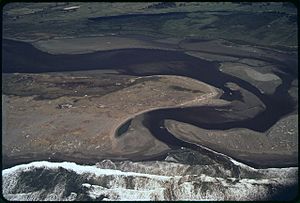Lake Earl facts for kids
Quick facts for kids Lake Earl |
|
|---|---|

Lake Earl from the Air
|
|
| Coordinates | 41°49′32″N 124°11′19″W / 41.825669°N 124.188693°W |
| Type | fresh water to saline lagoon |
| Primary outflows | Pacific Ocean |
| Basin countries | United States |
| Surface area | 6,900 acres (28 km2) |
| Surface elevation | 14 m (46 ft) |
Lake Earl is a special kind of lake called a lagoon located right on the northern coast of California, close to the border with Oregon. It's a big, beautiful body of water that's important for many reasons.
This lagoon is partly inside Tolowa Dunes State Park and partly in the Lake Earl Wildlife Area. It's found in Del Norte County, California. Lake Earl is known as the third most important place for seabirds on the West Coast, after the Farallon Islands and the Channel Islands.
Contents
Understanding Lake Earl's Sections
Lake Earl is actually made of two main parts, separated by a narrow area called "the Narrows."
- Lake Tolowa: This is the smaller part of the lagoon. It's closer to the ocean and has more salt in its water. The California Department of Fish and Game sometimes calls this part Lake Tolowa or Lake Talawa.
- Lake Earl: This is the larger part of the lagoon. Its water is mostly fresh.
Unlike an estuary, which is usually always open to the ocean, a lagoon like Lake Earl can get sealed off from the ocean by a sandbar. This happens during certain seasons. When it's sealed, the lagoon fills up mostly with fresh water.
Managing Water Levels
Lake Earl is the largest coastal lagoon in California. Because it can get sealed off from the ocean, its water levels can rise quite a bit.
- When the water level reaches about 8 to 10 feet (2.4 to 3 meters) above sea level, people manually open a channel to the Pacific Ocean. This helps to lower the water level.
- If the lagoon were allowed to open naturally, the water could rise even higher, up to 12 to 14 feet (3.6 to 4.2 meters).
When the water is at 10 feet (3 meters) above sea level, the lagoon has about 4,900 acres (20 square kilometers) of water and 4,950 acres (20 square kilometers) of wetlands. If the water drops to 2 feet (0.6 meters) above sea level, the open water area shrinks to about 2,191 acres (8.8 square kilometers), surrounded by 2,000 acres (8 square kilometers) of wetlands.
Fun Activities at Lake Earl
Because Lake Earl is in a quiet, natural area, it's a great spot for outdoor activities.
- Birdwatching: Many people come here to watch birds, as it's a very important area for seabirds.
- Duck Hunting: It's also a popular place for duck hunters.
- Fishing: You can fish for cutthroat trout in the lake.
- Kayaking: Some people enjoy kayaking on the lake, but it's not a very busy spot for it.
- Water Skiing: Please note that water skiing is not allowed on Lake Earl.
Protecting Endangered Species
Lake Earl is home to many animals and plants that are considered threatened or endangered species by California or the U.S. government.
When the United States Army Corps of Engineers plans to open the lagoon to the ocean, they work with the United States Fish and Wildlife Service. They need to make sure that opening the lagoon won't harm these special species.
Some of the important species found here include:
- The California brown pelican
- The Western snowy plover
- The bald eagle
- The Oregon silverspot butterfly
- The tidewater goby
Scientists have also checked on the western lily and found that opening the lagoon does not affect it. While Coho salmon used to be found here, they haven't been seen in the lagoon since 1989.
A Look at Lake Earl's History
The area around Lake Earl has a rich history.
- Native Legends: There's an old native story about a "Great Snake" that lives in the lagoon and sometimes goes out to the ocean. This story shows how important the lake has been to local people for a long time.
- Past Conflicts: In the past, there were disagreements in the area, including fights between cattle ranchers and loggers. Later, there were arguments between the government and private landowners about property rights.
- Flood Control: Lake Earl plays a big role in controlling floods for Del Norte County. Opening the lake's sandbar is very important for local sewers, wells, and managing water runoff from storms and heavy rains.
Protecting the Land Around the Lake
The California government has been working to protect the land around Lake Earl.
- In 1975, the California legislature passed the Keen-Nejedly Act. This law provided money for the California Department of Fish and Game to start buying properties for the Lake Earl Wildlife Area.
- Today, the Department of Fish and Game owns most of the land directly affected by the rising waters of Lake Earl. This land is part of the Lake Earl Wildlife Area and the Tolowa Dunes State Park.
- Other parts of the land are owned by different non-profit organizations and private citizens. The Department of Fish and Game plans to buy the remaining properties at a fair price.


